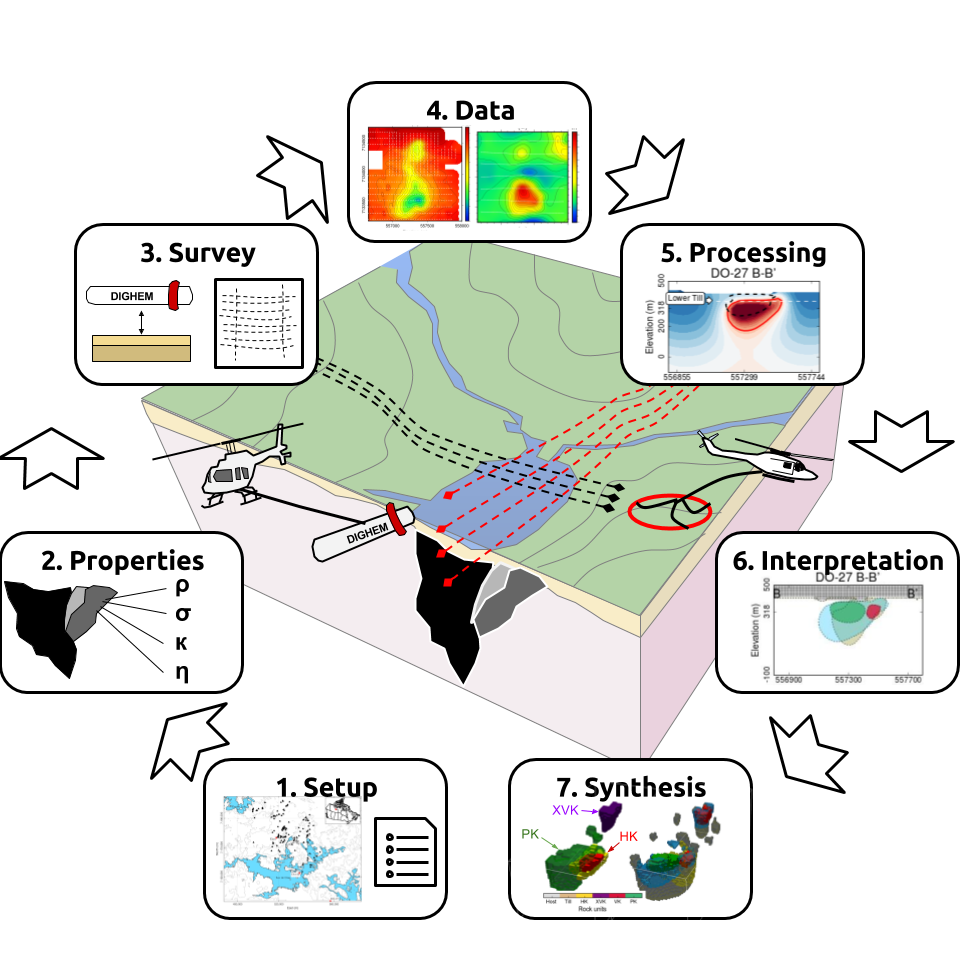
DO-27/DO-18 (TKC)
Authors: Dom Fournier, Sarah G. R. Devriese, Seogi Kang
Editor: Douglas Oldenburg
Special Thanks
Thanks to the Society of Exploration Geophysicists for permission to reproduce figures and adapt text from:
Sarah G. R. Devriese, Kristofer Davis, and Douglas W. Oldenburg (2017). ”Inversion of airborne geophysics over the DO-27/DO-18 kimberlites — Part 1: Potential fields.” Interpretation, 5(3), T299-T311. https://doi.org/10.1190/INT-2016-0142.1
Dominique Fournier, Seogi Kang, Michael S. McMillan, and Douglas W. Oldenburg (2017). ”Inversion of airborne geophysics over the DO-27/DO-18 kimberlites — Part 2: Electromagnetics.” Interpretation, 5(3), T313-T325. https://doi.org/10.1190/INT-2016-0140.1
Seogi Kang, Dominique Fournier, and Douglas W. Oldenburg (2017). ”Inversion of airborne geophysics over the DO-27/DO-18 kimberlites — Part 3: Induced polarization.” Interpretation, 5(3), T327-T340. https://doi.org/10.1190/INT-2016-0141.1
The material presented here has been modified from the SEG-published version and is subject to the SEG terms of use and conditions. This case history was presented as a part of the SEG 2017 Distinguished Instructor Short Course.
Abstract
The DO-27 and DO-18 kimberlites, often known as the Tli Kwi Cho (TKC) deposit, have been used as a testbed for airborne geophysical methods applied to kimberlite exploration. This case history attempts to characterize the DO-27/DO-18 kimberlite pipes based on four physical properties: density, susceptibility, conductivity and chargeability. Physical properties derived from 3D inversions are used to build a petrophysical model of the deposit. At least four rock types are identified and imaged at depth, which are compared to drilling results for validation. This study promotes the use of multiple geophysical methods for efficient diamond exploration programs.
The work presented is based upon the collaborative efforts of the UBC-GIF members. It summaries the results published in a three-part series on TKC:
Inversion of airborne geophysics over the DO-27/DO-18 kimberlites - Part 1: Potential fields by Devriese, Davis and Oldenburg [DDO17].
Inversion of airborne geophysics over the DO-27/DO-18 kimberlites - Part 2: Electromagnetics by Fournier, Kang, McMillan and Oldenburg [FKMO17].
Inversion of airborne geophysics over the DO-27/DO-18 kimberlites - Part 3: Induced polarization by Kang, Fournier and Oldenburg [KFO17].
Citations
[DDO17] : Inversion of airborne geophysics over the DO-27/DO-18 kimberlites - Part 1: Potential fields
[FKMO17] : Inversion of airborne geophysics over the DO-27/DO-18 kimberlites - Part 2: Electromagnetics
[KFO17] : Inversion of airborne geophysics over the DO-27/DO-18 kimberlites - Part 3: Induced polarization